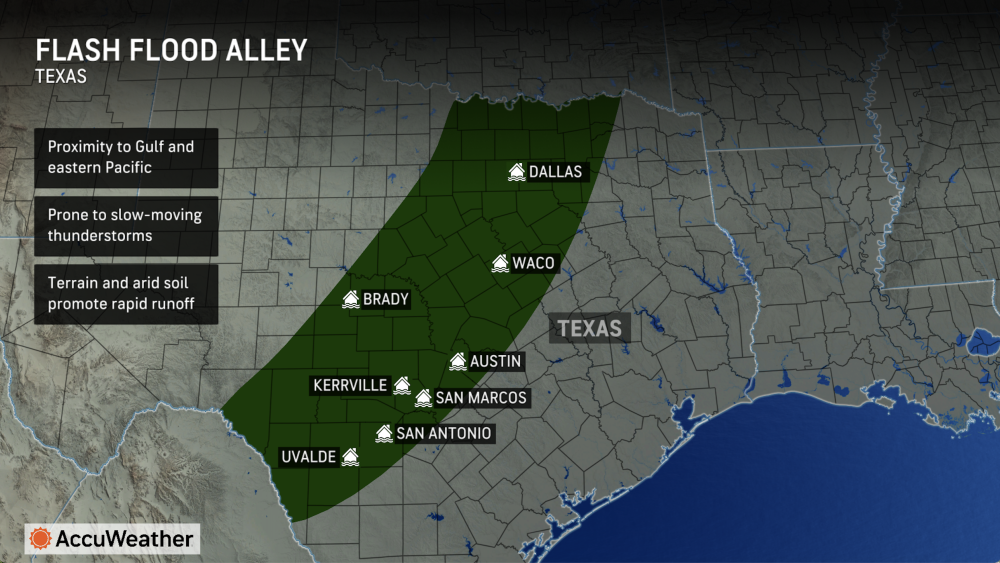Meteorologists say the region is frequently hit with floods, although some officials and residents were caught off guard by the catastrophic storms, which killed more than 100 people over the holiday weekend.
“No one knew this kind of flood was coming,” Kerr County Judge Rob Kelly said during a July 4 news conference. “We have floods all the time. ... When it rains, we get water. And we had no reason to believe that this was gonna be anything like what’s happened here.”
As of July 10, local and state officials said at least 119 people were confirmed dead as a result of the flooding, including 96 fatalities in Kerr County, eight in Kendall County, seven in Travis County, four in Burnet County, three in Williamson County and one in Tom Green County.

About 12 inches of rain fell in the Texas Hill Country during the July 4 weekend, according to the forecasting company AccuWeather. As a result, the Guadalupe River in Kerrville rose more than 30 feet in 90 minutes, peaking at 34.29 feet at 6:45 a.m. July 4, a local river gauge showed.
Much of the Hill Country flooding occurred before sunrise on July 4, and officials said some residents and visitors missed or did not receive emergency alerts issued by the National Weather Service.
Lt Gov. Dan Patrick told Community Impact that the flooding was so deadly because it “came while everyone was sleeping.”
“Some didn't wake up. They never heard the storm was coming, and they lost their lives,” Patrick said in a July 8 interview. “When you look at that storm... [it was] the worst possible storm, the worst possible amount of rain and the worst possible spot—in the middle of the night, with vulnerable children at a camp.”
Officials said at least 27 campers and counselors were killed at Camp Mystic, a girls’ Christian summer camp located along the Guadalupe River in Hunt.
What they’re saying
Patrick and some Texas lawmakers have said they intend to fund flood warning sirens to be installed along the Guadalupe River and in other flood-prone areas during a 30-day special legislative session, which begins July 21. On July 9, Gov. Greg Abbott directed lawmakers to draft legislation related to flood warning systems, emergency communications, natural disaster preparedness and relief funding for impacted Hill Country communities.
Abbott’s 18-item agenda also includes tightening regulations on THC products, implementing a new standardized test for K-12 students and redrawing Texas’ congressional districts. Under the Texas Constitution, only the governor can designate policies for a special session.
“In high flood-prone areas such as the Guadalupe River Valley, those need to be hardwired, fixed sirens that go off with automated systems when water levels reach a certain level,” Rep. Drew Darby, R-San Angelo, said in a July 9 interview. “The state needs to pay a large part in funding some of this early warning equipment.”
One person died due to July 4 flooding in San Angelo, according to local police. Darby said flooding is uncommon in the community, due to limited rainfall, noting that the area received “over 14 inches in a 12-hour period.”
“[It’s] frustrating, because floods in the Guadalupe River Valley occur more often and they're more intense,” Darby told Community Impact. “In my opinion, we should have a more formalized warning system that alerts visitors and residents and campers in that area of the dangers involved in real time.”
More details
Eric Berger, a Houston meteorologist who founded forecasting sites Space City Weather and The Eyewall, said that extreme rainfall is particularly difficult to forecast.
“There were some indications that there was going to be very heavy rainfall, but prior to about 12-24 hours before it occurred, it was difficult to pinpoint precisely where,” Berger told Community Impact. “Forecasters... didn't really have the confidence to say definitively whether it would occur and certainly where it would occur.”
During a July 4 news conference, Texas Division of Emergency Management Chief Nim Kidd noted that the National Weather Service “did not predict the amount of rain that we saw,” pointing to forecasts that he said projected about 4-8 inches of rain in the Hill Country.
“The amount of rain that fell in this specific location was never in any of those forecasts,” Kidd said.
At 1:18 p.m. July 3, the NWS issued a flood watch indicating the potential for heavy rain and the “flooding of low-lying areas” for a portion of south central Texas, including Kerr County. The first flash flood warning for Kerr County was issued after 1 a.m. July 4, and the NWS declared a “flash flood emergency” for the area around 4 a.m.
“I think the forecasters more or less did the right thing by raising the alert level to let people know that something was possible, and then when they finally had confidence, pulled the triggers on these very dire warnings,” Berger said. “I think a major part of the problem is that this occurred after midnight on a holiday weekend, which is really kind of the worst timing in trying to get that kind of messaging out.”
State climatologist John Nielsen-Gammon said forecasters have to walk a fine line when issuing warnings in flood-prone areas like the Hill Country.
“[In] the Hill Country, there's flash flooding frequently,” Nielsen-Gammon said in an interview. “Somehow or another, you have to get the word out to everybody when there's a particularly dangerous situation, but not warn them about it too frequently, or else they'll start ignoring it when the danger doesn't materialize. A lot of that can be public education.”
One more thing
Extreme rainfall is becoming more frequent and intense in Texas, Nielsen-Gammon noted in an April 2024 report. The report found that the intensity of extreme rain could increase by 10% between 2020-2036.
Nielsen-Gammon told Community Impact that climate change has led to warmer oceans and warmer air. A warmer atmosphere can carry more water, he said, causing intense rainfall.
“With climate change, you've probably doubled the frequency of extreme rain,” he said.





